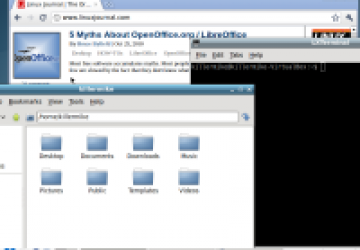Lubuntu: Light(er)weight Ubuntu-based Distro

Lubuntu 10.10 mates the standard Ubuntu 10.10 base system with LXDE, a lightweight desktop environment. Lubuntu isn't a super light distribution like Puppy Linux, but the target is older computers and other resource constrained hardware such as netbooks. If you’ve ever wished that you could use Ubuntu in situations where you didn’t quite have the horsepower, Lubuntu could be for you.
Note that, although based on Ubuntu, Lubuntu isn't yet an official member of the Ubuntu family, although full acceptance is an aim of the development team.
Like its big brother Ubuntu, part of the appeal of a distribution like Lubuntu comes from its ease of installation. To this end, Lubuntu installs a complete set of tools and applications with only an essential set of install time configuration options. Basically, if you've installed any other *buntu, you have a good idea of what to expect: the disk boots into a live CD with an option to install the operating system to a HD.
So, what does Lubuntu actually offer? LXDE is a lightweight desktop environment, itself based on the extremely efficient Openbox window manager. As well as responsiveness on less powerful machines, it has has comparatively low power requirements, increasing battery life and saving money. In terms of the default visual layout, Lubuntu has an application launcher that sits on the left hand side of the taskbar which runs along the bottom of the screen. In other words, no real surprises for the average computer user.
LXDE is more than a mere window manager, and it comes with components such as a file manager, an archive manager, a configuration tool, a media player, a terminal, and some other small utilities. The file manager, PCManFM is functional, but suffers from a few compromises. For example, like most of the smaller file managers, it doesn't feature a SAMBA browser.
Lubuntu makes use of, in keeping with the speedy theme, the Chromium web browser. For productivity applications, the developers have borrowed from the unofficial Gnome “office suite”. These applications include spreadsheet Gnumeric and word processor Abiword, two applications that I consider to be highly capable and chronically underrated.
Conclusion
If you don’t need a standardised, easy to install solution, you could build something similar to what Lubuntu offers, and lighter still, by beginning with a Debian netinstall and then adding LXDE and any other components that you need.
In many ways, Lubuntu is a example of what’s so great about Linux as it offers yet another balance of options and compromises by positioning itself between the genuinely light weight distributions and the full, mainstream solutions based on KDE and Gnome.
If you've ever wanted to install Ubuntu but wished that it was a bit less resource heavy, Lubuntu might be for you. Although the website claims that it is usable on machines with 256MB and sub 1 GHz processors, it’s clearly going to work best on machines with a CPU that’s a little bit above that level and closer to 512MB of RAM. However, this is an important niche as there are many machines of that speed lying around and in need of a well featured, secure operating system.
The other target is netbooks. Here too, Lubuntu may well be a valid choice for people who could just about run a more standard distribution but want to get out from underneath the escalating memory footprint and CPU drag of KDE and Gnome and enjoy some extra speed and battery life.
In both usage cases, Lubuntu could well see some of these machines saying a final farewell to Windows XP.
The Lubuntu website










